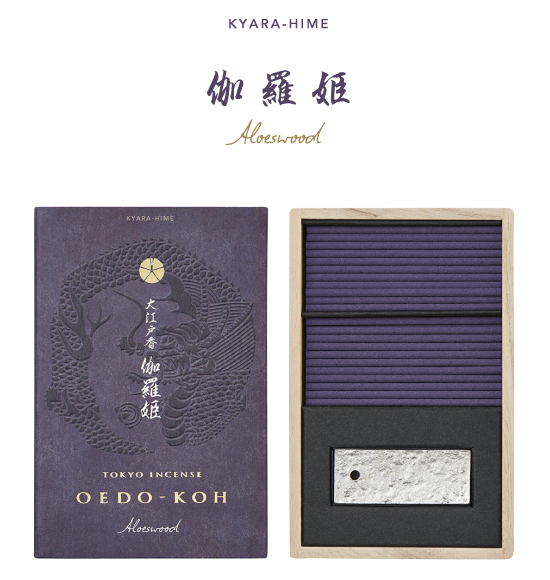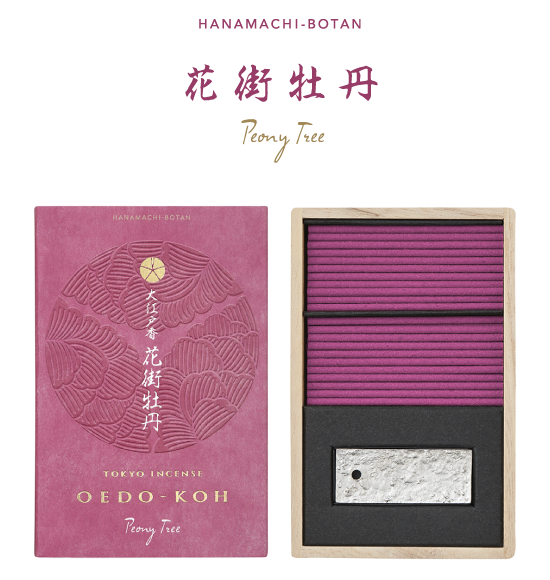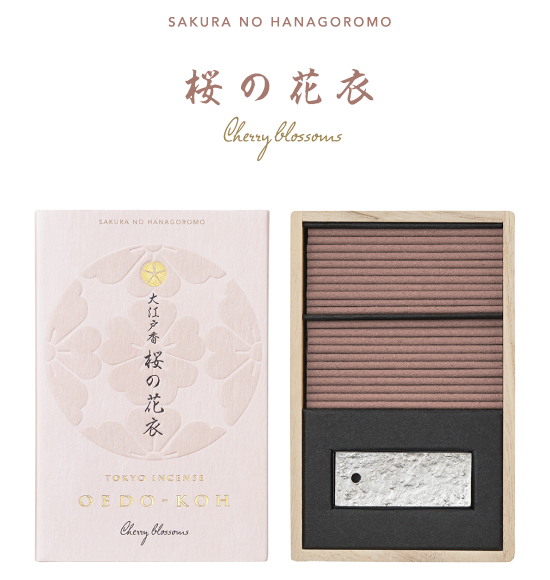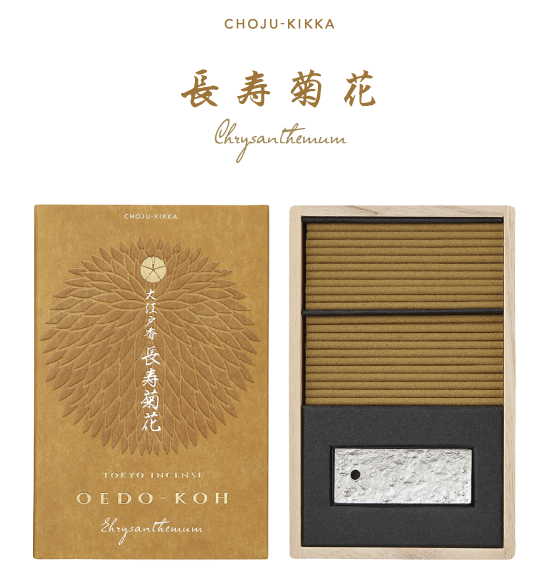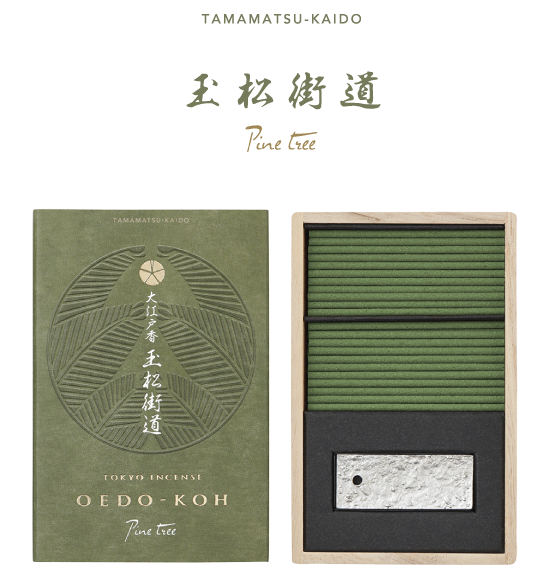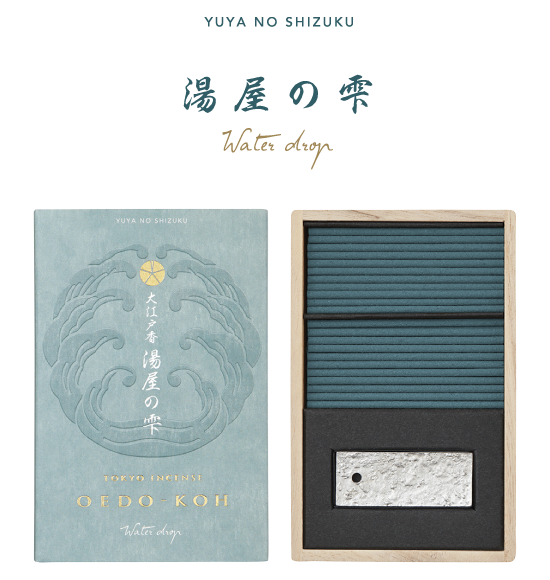お香 大江戸香
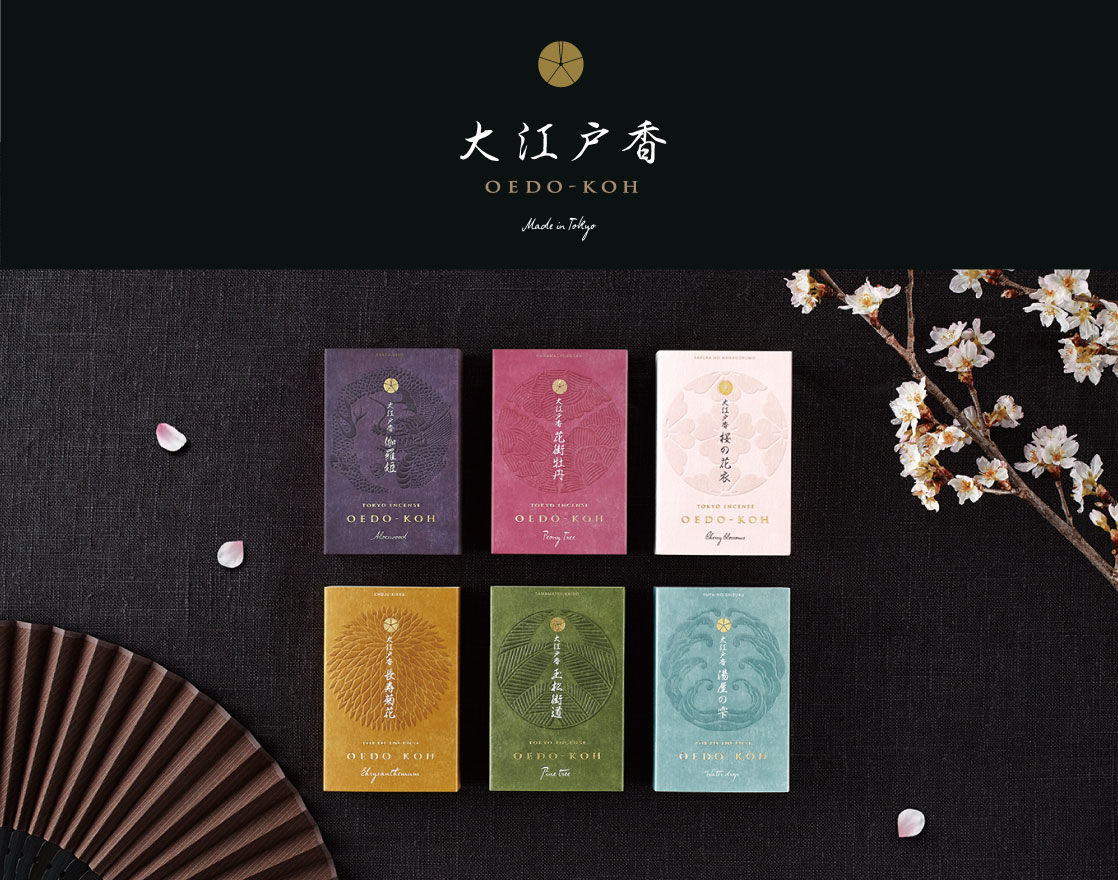
- 受継がれた薫香技術とパフューマ―が織りなす
江戸を楽しむ香り遊び。 - 「雅」と「俗」の文化交流が作り上げた、遊びと洒落の江戸文化。
四季を楽しみ、えにしを尊び、人々がいきいきと暮らしていた江戸の町。
江戸の匂い立つような暮らしぶりを、ここ江戸は東京の香司が香りで表現。
ひとすじのけむりが、粋でモダンな江戸の世界へとご招待。
さあさあ、江戸の香り世界へようこそ。 - The culture of Edo (the old name of Tokyo) was a playful and stylish one, born out of a marriage of
the elegant and the common, the coarse and the refined.
People enjoyed the four seasons, treasured their friends and neighbors, and lived lives brimming with vitality.
This series was created by master incense artisans in Tokyo to express the fragrant atmosphere of old Edo.
A single thin column of smoke beckons you to the stylish, modernist world that Edo represents.
We invite you to bask in the fragrant world of Edo.
大江戸香のこだわりHIGH QUALITY INCENSE "OOEDO-KOH"
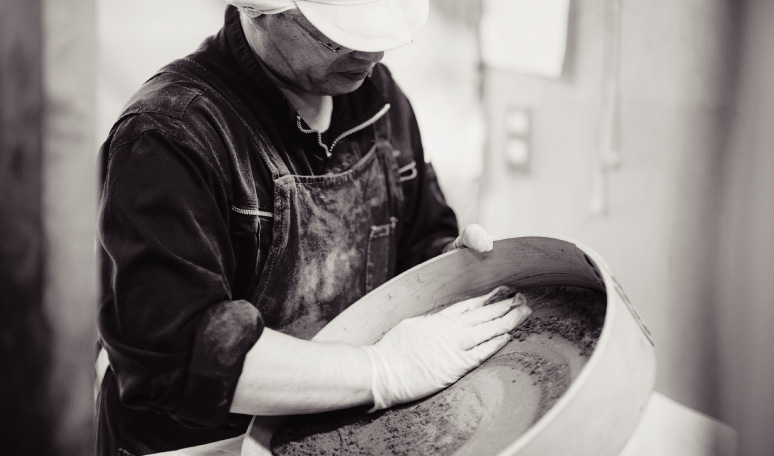
お香についてABOUT THE INCENSE
お香は江戸の物語に合わせて特別に調香し、
日本の伝統色で彩りました。
東京の職人がひとつひとつ丁寧に手作りしています。
These fragrances have been specially blended to correlate with the folk tales that were told during the Edo Period.
Each incense is colored with traditional colors.
One by one, these products are carefully hand crafted by the skilled craftsman of Tokyo.
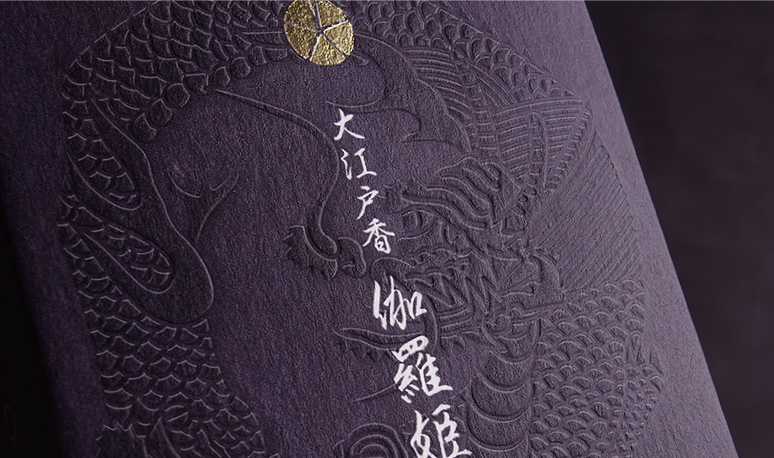
パッケージについてABOUT THE PACKAGING
日本の伝統的な紋様と色を使用し、桐箱におさめました。
手触りや質感にこだわったデザインに仕上げています。
箱の内側にも浮世絵を施し、江戸の美学を表現しています。
The incense is nestled in a paulownia box while the packaging is adorned with Japanese patterns in traditional colors. We paid special attention to textures and made sure the packaging has a luxurious surface finish.
The Ukiyo-e paintings printed inside the package express the aesthetic during the Edo period.
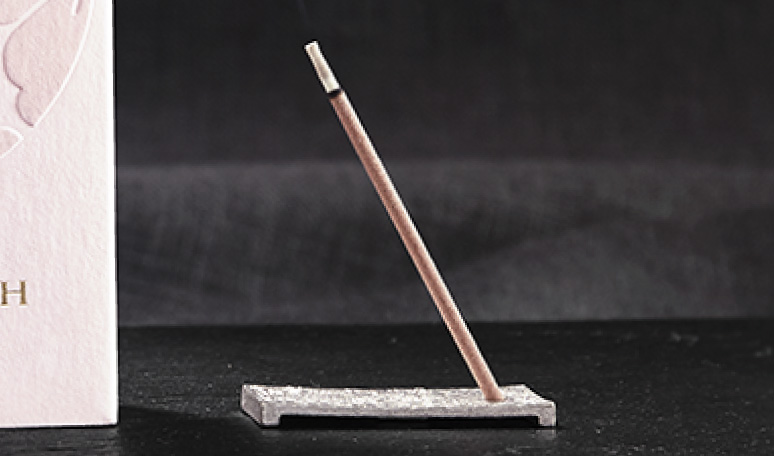
香立てについてABOUT THE INCENSE HOLDER
お香には江戸の石畳を模した香立てがついています。
江戸で位の高い人たちに人気だったといわれる錫製の香立は、水洗いも可能で、さびにくく長くお使いいただけます。
Each incense includes an incense holder that resembles the stone pave ments of Edo. Tin was a favored metal by the upper class during the Edo period. The tin incense stand included in the package can be washed with water and will last for a long time.
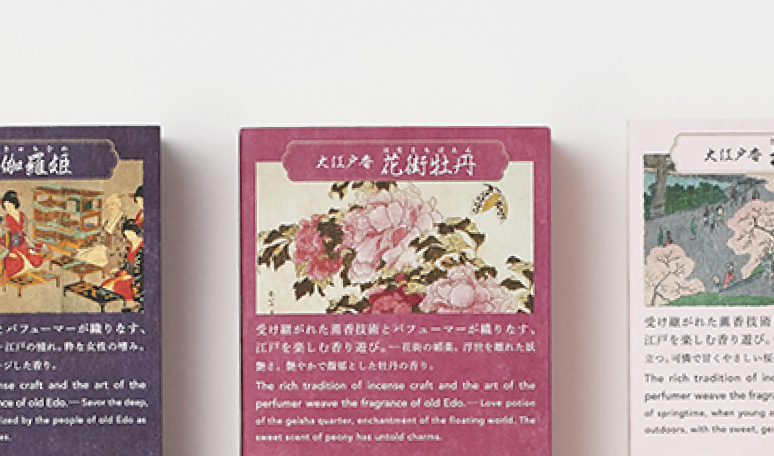
日英2カ国語表記ENGLISH TRANSLATION
商品には英語による説明が表記されておりますので、海外へのお土産にもおすすめです。
The product comes with an English explanation so it would be a great souvenir gift for recipients in any country.

公家から大名などの富裕層へも広がりをみせた「香道」。
庶民の間でも香木への想いは強く、歌舞伎や浄瑠璃の演目にあでやかに登場。当時、伽羅という単語は”すてきなもの”を形容する表現に。さらに「伽羅の油」という生薬で香りづけした鬢付油も大ヒット。
江戸の人々にとって憧れの的だった伽羅をイメージした香り。
Incense-smelling ceremonies were the practice of court nobles, feudal lords and other wealthy people.
Among commoners as well, while they may have lacked access to genuine fragrant woods, there was much fascination with them, and they are frequently featured in works of Kabuki and Joruri theater.
The word kyara, meaning aloeswood, even became a general term for “something wonderful.”
Hair wax that evokes the scent of aloeswood was extremely popular as well.
Experience the fragrance, and understand why it was the most highly prized of scents.

江戸で人々を魅了し、爆発的な人気を誇った牡丹の花。
その姿は妖艶で美しい芸者たちを連想させ、歌と踊りが聞こえてくるよう。
限られた者だけがお座敷で楽しむことのできる芸の世界。
江戸の町では茶屋での芸の時間を香の煙で計ったこともあったとか。
そんな浮世を離れた美しさを想起させる“百花の王”牡丹の香り。
The enchanting peony enjoyed enormous popularity in Edo. Its bewitching form is reminiscent of a beautiful geisha, and gazing upon a peony you can almost hear the music and see the dances of the geisha quarter.
This was an exclusive world for the privileged few, and it is said that customers’ time spent in teahouses was measured by sticks of incense. The fragrance of the peony, “queen of the flowers” evokes this beautiful and evanescent world.

江戸時代に本格化する花見文化。今もなおその美しさを受け継ぐ染井吉野は幕末に江戸の郊外 “染井村” から出た園芸種。江戸の人々にとって、花見は出会いの場であり、自分をみせるパフォーマンスの場。「花衣」というおそろいの衣装をまとい、春を喜び歌い踊ることもあったとか。
春を彩り人々を魅了し続ける桜の香り。
The custom of cherry blossom viewing took hold during the Edo Period.
The somei-yoshino cherry tree, seen in groves throughout Japan today, was originally an ornamental garden variety raised in the village of Somei near Edo. Cherry blossom viewings were also an opportunity for Edo denizens to meet one another, present themselves, and perform : matching fancy kimonos were worn for the occasion, and people sang and danced to celebrate the coming of spring.
The captivating scent of cherry blossoms heralds spring’s arrival.

江戸の菊ブームは江戸近郊の駒込・巣鴨の植木屋が火付け役といわれ、花壇菊、菊細工など、派手好きの江戸っ子は形も香りもよい菊に熱狂。古来より延寿の力があるといわれ、薬草として用いられた菊を浸した菊酒で祝う、重陽の節句(菊の節句)が五節句の一つとなったのもこの時代。
江戸っ子に愛された清涼でなめらかな菊の香り。
The gardeners of Komagome and Sugamo near Edo are said to have sparked the chrysanthemum craze of the Edo era.
Fond of the fancy and spectacular, Edo dwellers loved the beautiful and fragrant flowers, which were displayed or fashioned into various shapes. Chrysanthemums were believed since ancient times to prolong life, and during the Edo Period the Chrysanthemum Festival became a yearly event where people drank chrysanthemum sake infused with medicinal blossoms. The smooth, refreshing scent of chrysanthemum will delight you as it did the denizens of old Edo.

神は常緑樹に宿るといわれ、木に降りてくるのを「待つ」という意味にもひっかけて、松竹梅、鶴と松、門松、能舞台など、松は長寿や縁起物の象徴に。
浮世絵にも、江戸時代の人々の往来の中に、堂々と描かれた松は当時の象徴的な風景の一つ。
旅の無事を祈りつつ、街道を行き来する人々を見守り続けた清々しい松の香り。
It is traditionally believed that the kami (deities) dwell in evergreen trees. The word matsu means both “pine” and “to wait” (for the deity to descend), and the pine is part of the felicitous trio of pine, bamboo and plum tree, and the auspicious pairing of crane and pine. Pine decorations are displayed at New Year’s, and a monumental pine tree is painted on the backdrop of the Noh stage – all expressing the pine’s association with luck and longevity. In ukiyo-e woodcuts, boldly rendered pines standing in the midst of Edo-era people bustling to and fro are a classic motif. Savor the refreshing scent of pine, the tree that guards the travelers’ road and watches over their safe return.

江戸時代はまだ家に風呂がなく、湯屋が次々に作られ、その数約600軒。
初期の蒸し風呂のようなものから次第に湯船の形式へ。湯屋では身分を越え、老若男女問わず文字通り裸の付き合い。湯上がりには、蘭引(らんびき)とよばれる蒸留器で花を蒸留した化粧水なども人気だったとか。
あたたかくふわりと香る華やかな湯上がりの香り。
In the Edo Period (1603-1868) people didn’t have baths at home, and public bathhouses were built to meet the need. There were about 600 in Edo. At first they were steam baths, then large bathtubs were developed. As all were naked and people comingled without regard for age, gender, or rank, the bathhouse was an egalitarian place. Apparently another popular item was a scented lotion made with floral essences distilled using a still known as a ranbiki.
This fragrance has the warmth and friendly glow of the moment you step out of the bath.
-
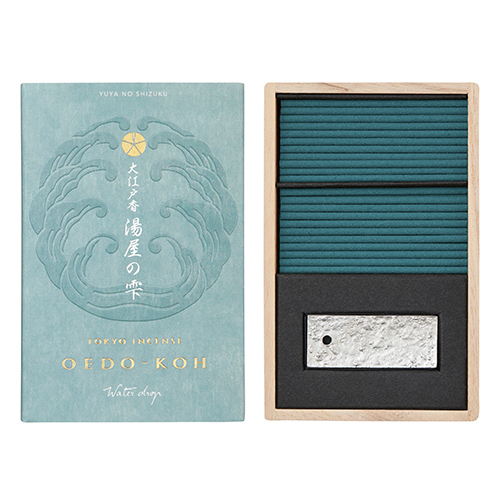
お香 大江戸香 湯屋の雫(ゆやのしずく) 60本入
江戸を楽しむ香り遊び「大江戸香」。あたたかく華やかな「湯あがり」の香り。
¥1,815
-
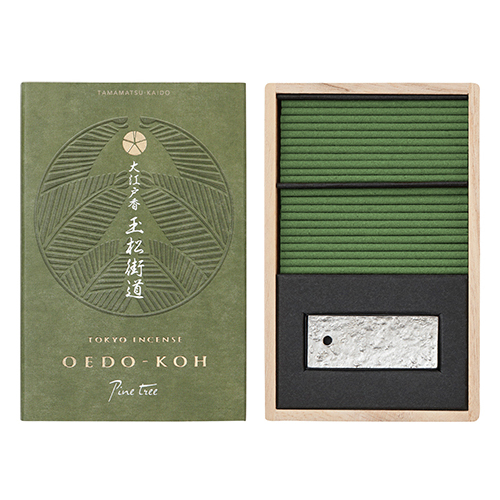
お香 大江戸香 玉松街道(たままつかいどう)
江戸を楽しむ香り遊び「大江戸香」。力強く清々しい「松」の香り。
¥1,815
-
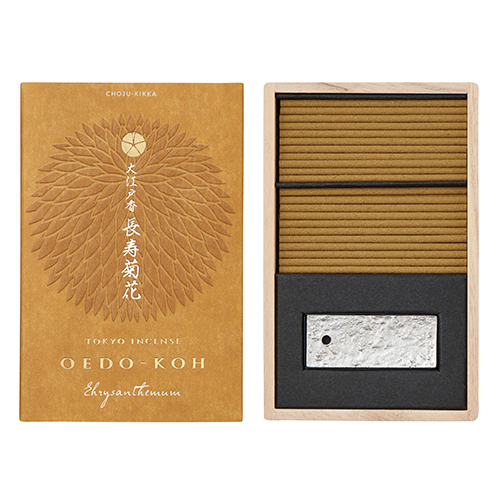
お香 大江戸香 長寿菊花(ちょうじゅきっか)
江戸を楽しむ香り遊び「大江戸香」。清涼でなめらかな「菊」の香り。
¥1,815
-
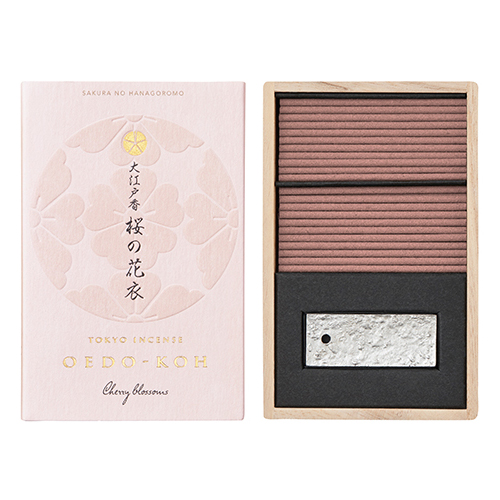
お香 大江戸香 桜の花衣(さくらのはなごろも)
江戸を楽しむ香り遊び「大江戸香」。甘くやさしい「桜」をイメージた香りです。
¥1,815
-
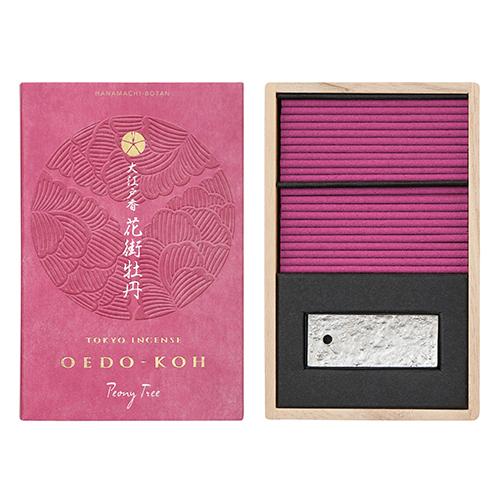
お香 大江戸香 花街牡丹(はなまちぼたん)
江戸を楽しむ香り遊び「大江戸香」。艶やかで馥郁とした「牡丹」の香り。
¥1,815
-
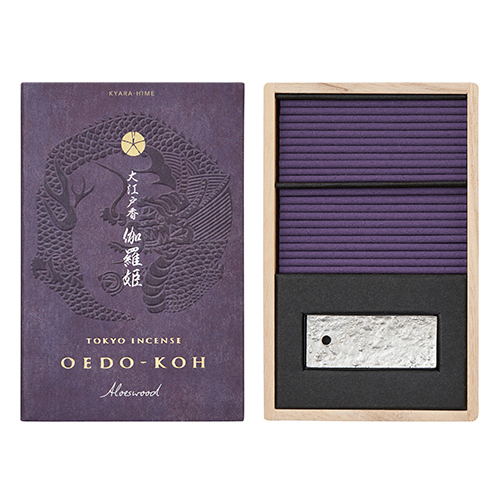
お香 大江戸香 伽羅姫(きゃらひめ)
江戸を楽しむ香り遊び「大江戸香」。味わいのある「伽羅」をイメージした香りです。
¥1,815
